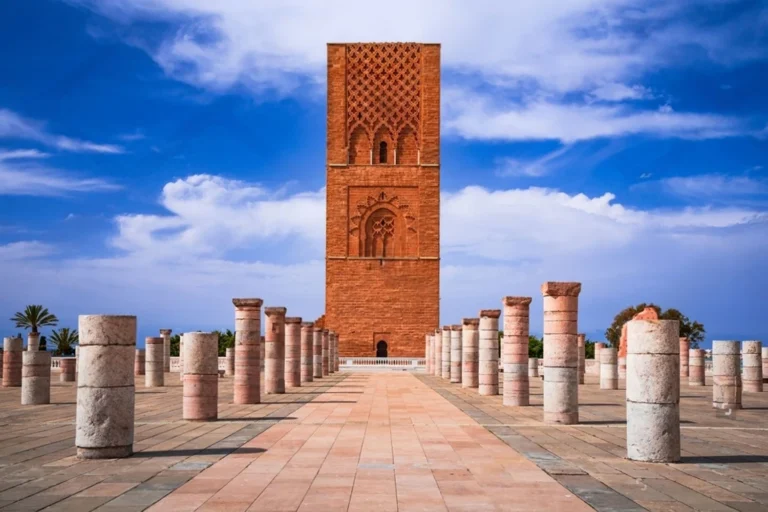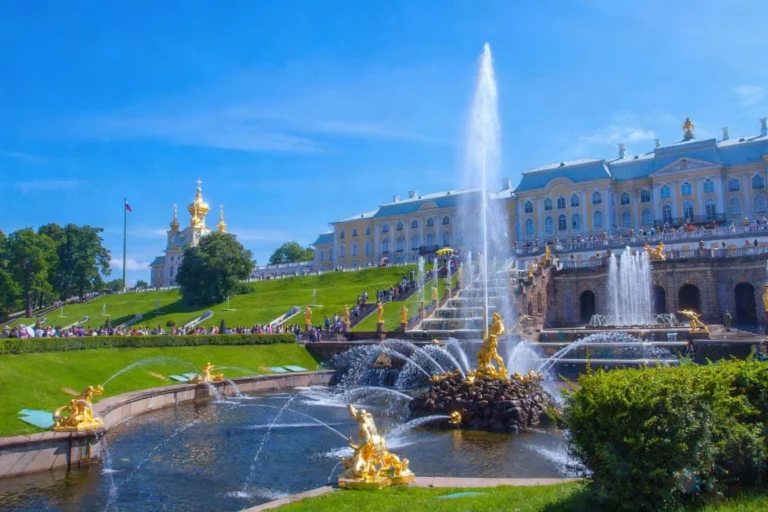Madrid: 30 Curious Things Hidden Behind the Sunlight
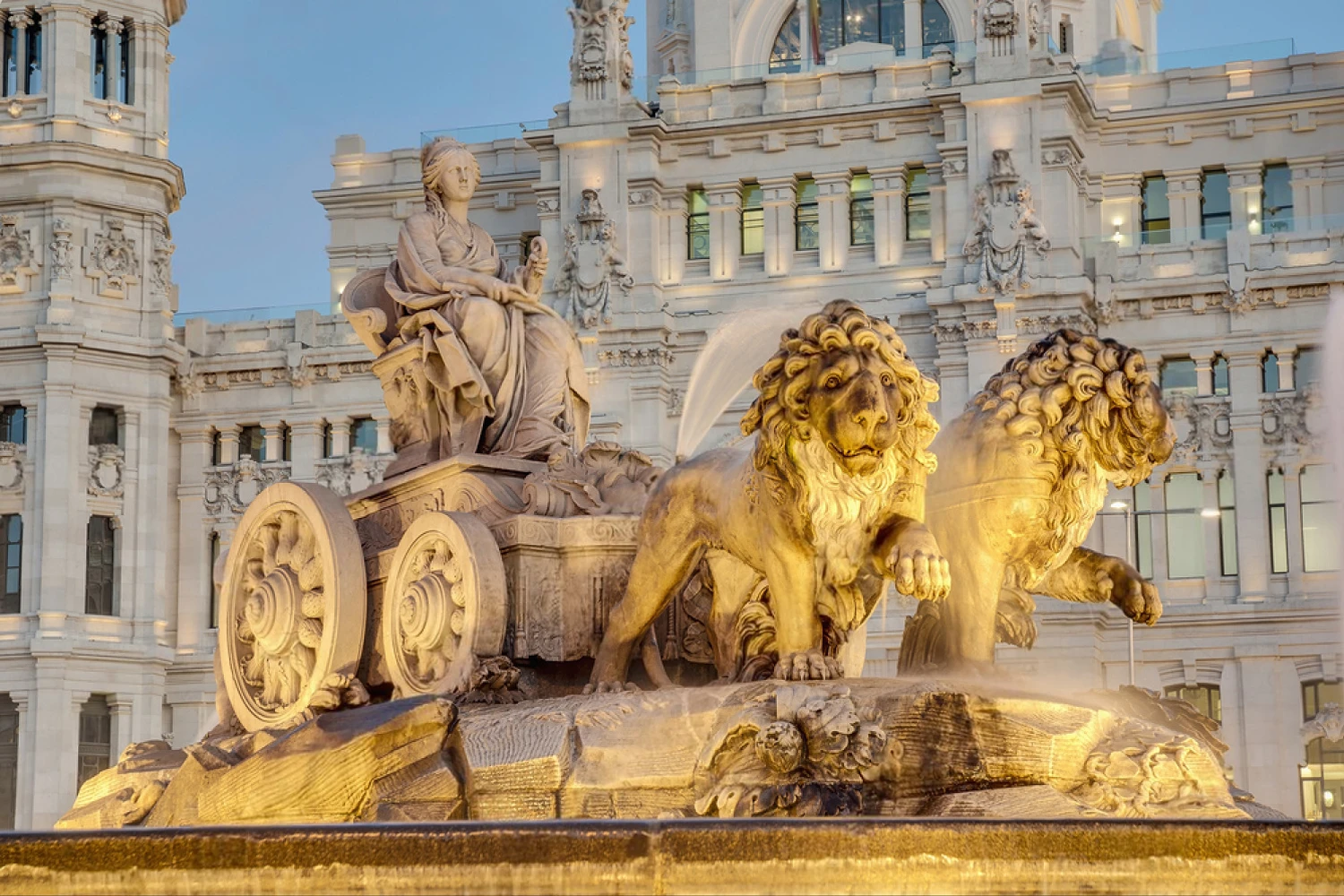
In Madrid, I find the stories that stay with you aren’t the ones printed on postcards, but the ones you almost pass by in ordinary moments. Walking here can feel like peeling a sun warmed orange slow, fragrant, and a little sticky with memory. There’s the low clink of cups behind a half open door, the cool brush of shade on your skin, and the soft scuff of shoes across worn stone. Linger with these small signs, and a deeper spirit shows itself in overlooked details and the brief kindness of strangers.
Europe’s sunniest capital and the art of lingering
I remember that light that lingers long past dinnertime soft on stone, warm on faces. Nearly four thousand hours a year, they say, and you feel it in your bones: a generous blue ceiling stretched over everything, letting errands turn into conversations, and conversations into the kind of pauses that make you smile for no reason.
By late evening, the city is wide awake, and I finally understood why people stay out, lingering on terrazas, sipping something cold while the air still carries a gentle warmth. In Madrid, there’s no hurry to step inside; you notice the clink of glasses, the citrus on your fingers, the way laughter settles into the long hours. It feels like the sun is a long winded storyteller, and everyone leans in for just one more tale.
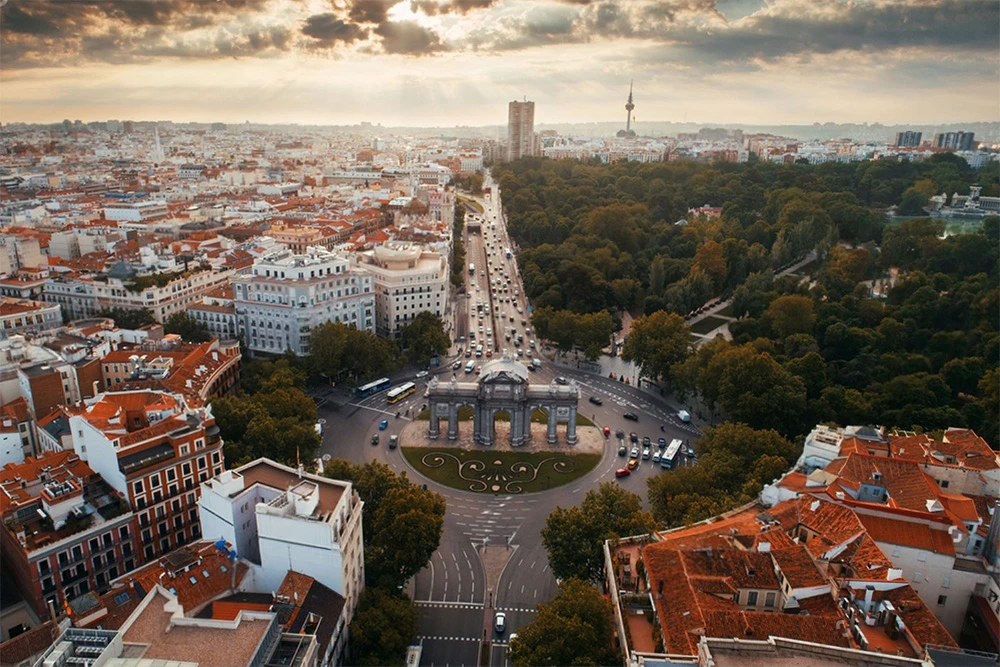
Why locals proudly call themselves cats after nightfall
I remember laughing the first time someone said, “I’m a cat.” Then came the story: long ago, a soldier scaled the city walls so nimbly that people said his palms landed on the stone like soft paws, and the nickname stuck. It’s one of those legends that slips under your skin because it explains a feeling you already had the sense that the place belongs to the night as much as the day, and that being from here means carrying a quiet dare in your bones.
In Madrid, you notice it when the streets breathe deeper after midnight the city purrs after nightfall. Light spills from doorways onto worn cobbles, the smell of churros and coffee lingers, and laughter threads through the alleys with a confidence that feels inherited. Locals wear “cat” like a small badge of mischief and tenderness, happy to keep the hours when stories loosen and neighbors become conspirators. Hearing it made the night feel friendlier to me, as if the city was gently inviting everyone to linger, to be curious, and to claim a little corner of darkness as home.
The world’s oldest restaurant still cooking in Madrid
It still surprises me how a dining room can feel older than your family stories. The air comes warm as fresh bread, carrying a hush of wood and roasted meat; glasses chime softly, and somewhere an old oven glows like a steady heartbeat. You breathe in, and it’s as if the walls have learned to keep memories the way they keep heat.
Sobrino de Botín has been serving since 1725, which feels almost impossible until you’re inside and the centuries feel close and ordinary. The detail that always gets me is Goya before the masterpieces, before the fierce eyes and dark skies working there as a dishwasher, sleeves wet, invisible in the bustle. It’s comforting, somehow, to know even a genius once lived in the steam and clatter, letting life season him slowly.
Maybe that’s why the place lingers with you: it turns time into something you can taste. I remember thinking how a simple plate can feel like a handshake across time, a quiet promise that craft and hunger and hope don’t really change. In a world that keeps speeding up, that kind of steadiness feels like grace.

A steady handed race where no wine spills
I remember the hush before the first sprint; shoes tapped over warm cobblestones, glasses chimed, and sunlight slipped along the necks of wine bottles. A waiter drifted past with a tray that trembled but never betrayed him, like balancing a small sea in his hands; not a drop dared jump.
Every year, in Lavapiés, a small neighborhood turns this into a celebration of care: neighbors leaning from balconies, kids with ice cream, travelers on curbs, all cheering for hands that don’t spill. It’s a love letter to hospitality, a gleeful ritual that makes the whole crowd feel welcome, and I walked away with that bright, communal buzz that lingers long after the last cheer.
Cocido madrileño, a three act ritual of warmth.
The first spoonful always hushes the table, and you feel your shoulders drop. In Madrid it arrives like a gentle procession: a golden broth first, steam curling up, the kind that seeps into your chest until you breathe easier. I remember a gray afternoon when that soup felt like a wool scarf pulled close, and suddenly winter wasn’t quite so stern.
Then the chickpeas and vegetables arrive, earthy and unhurried, and everyone leans in. There’s a rhythm to it, the way conversation loosens between bites, the way laughter lingers a little longer than the taste of garlic. By the time the slow cooked meats make their entrance deep, tender, generous you’re already sharing stories you didn’t realize you needed to tell.
That’s what I love about cocido: it isn’t just a meal. Those three rounds make space for an afternoon of being human unrushed, chatty, content and you end up full in the best possible way. You leave the table warmed from the inside out, and the day feels a little softer.
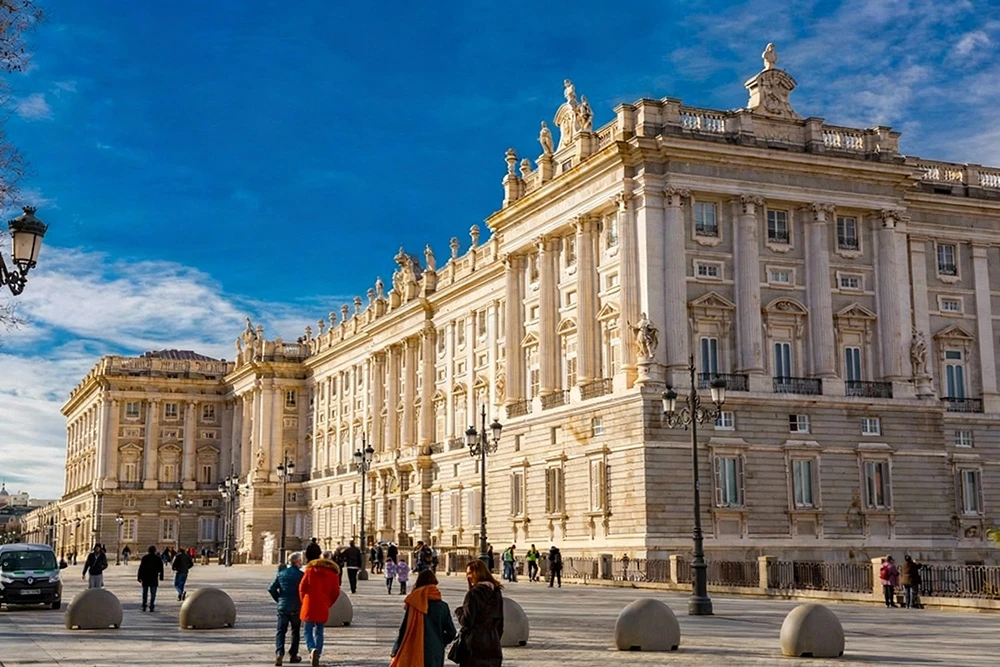
An Egyptian temple where evenings glow with gold
It still makes me blink hieroglyphs breathing in the evening air, just above Plaza de España. The stones turn honey warm as the shallow pool holds a patient mirror; there’s soft chatter, a stray guitar, and the pines give the breeze a resin sweet smell.
This is the Temple of Debod, raised in the 2nd century BC beside the Nile and sent here as a gift from Egypt a grateful thank you for Spain’s help saving ancient monuments in the 1960s. Standing there, it feels like a thank you letter in stone few words, deep meaning, signed by time.
I love how Madrid doesn’t fuss over it; it simply offers space, sky, and a quiet hill where the sunset lingers. In that calm, the temple becomes a small bridge of sun warmed granite between two worlds, and you can sense how rescue turns into friendship, and history into everyday grace.
A few delayed seconds unite Spain’s midnight grapes
I love how a country can borrow a breath from the year’s last minute just to be together. At Puerta del Sol, the old clock gets a gentle nudge, delayed by a few precious seconds so the TV chimes reach living rooms everywhere at the same perfect moment. The winter air tastes like metal and cava, bowls of green grapes sweat on tables, and there’s this hush before the first bell, a small shared pause from north to south.
I remember learning that and smiling at the kindness of it the way a sliver of time is gifted so no one misses the beat. Twelve quick bites of hope, skins popping softly between teeth, sticky fingers and nervous giggles, and then the whole country breathes out together. It’s such a simple trick of timing, but it feels like a conductor lifting the baton, steadying a nation so midnight arrives in one clear, ringing note.

Lanterns for the Blessed Souls of Purgatory
There’s a shiver sweet hush when the lanterns appear. On November 1st in La Latina, they honor the “Blessed Souls of Purgatory,” and the night glows with beeswax and tangerine light. Costumes rustle black lace, paper crowns, a few playful masks and someone starts a ghost story that makes the crowd lean closer. The street turns into a slow river of amber over the old stones, and you can almost taste the chill as it slips past.
I remember thinking how tender it is to celebrate the ones between worlds neither here nor gone, but still worthy of a path lit home. In those narrow streets, folklore doesn’t feel distant; it walks beside you, soft voiced and familiar, until the city’s memory seems to breathe through the stones. It’s a gentle, haunting kind of comfort, the sort you only find in the older neighborhoods, where people still leave room for mystery.
https://en.wikipedia.org/wiki/Madrid
A statue that tastes like the city
I always smile when I pass the bear nuzzling the strawberry tree; it never feels like a quirky mascot, more like a memory standing guard over Puerta del Sol. On hot afternoons the bronze glints warm and soft, and it hints at the forests that once covered these hills.
You still spot madroño trees around town, their leathery leaves throwing shade and their berries turning into liqueurs and jams. I remember the taste tart sweet, a touch resinous, the kind of flavor that hangs around and warms the chest. The bear, to me, is a gentle nod to the wildlife that wandered here long before us, a reminder that this city keeps a paw in the wild even as we hurry past.
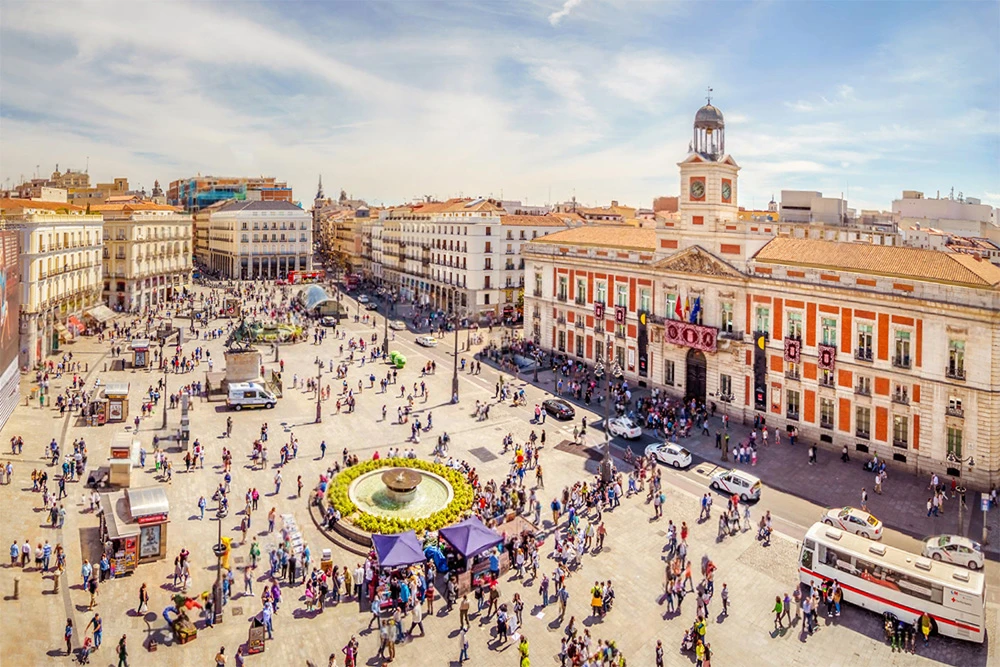
The highest gardens hiding under the city’s palace
I always forget how the noise thins out here, as if someone nudged the city’s volume knob and the day exhaled. These are the highest gardens, somehow sheltered under the palace walls cool shade, gravel soft underfoot, fountains whispering, and a peacock stepping out like a tiny, well-dressed concierge. It feels like a page in the storybook the crowds never dog eared.
Even on the loudest weekends, Campo del Moro slips under the radar; you can wander the secretive paths and feel the green hush become yours for a while. I remember how my shoulders finally settled, how the air felt kind, and how even the city seemed to pause out of respect. It’s a small, steady peace in a place known for brightness and noise.

Giant puppets in a whispering corrala museum
Some Saturdays, it just feels right to step off the noisy street into the hush of old wood and soft echoes. Tucked inside a traditional corrala with creaking wooden galleries and a stripe of sun across the railings, the Museum of Popular Arts and Traditions waits like a secret you share with a friend.
I remember the first grin of a giant festival puppet painted cheeks, eyes too bright standing beside embroidered skirts that seemed warm from some long ago dance. The displays are free, and somehow that makes the rooms gentler; you drift past lace cuffs and patched aprons, like opening the city’s attic and finding it full of laughter.
What stays with me is the hush: a parade paused mid breath, the clatter of Madrid left at the door while stories keep speaking in thread and papier mâché. It turns time travel into a tender, quiet errand just a small, happy Saturday that lingers in your chest long after you step back into the light.
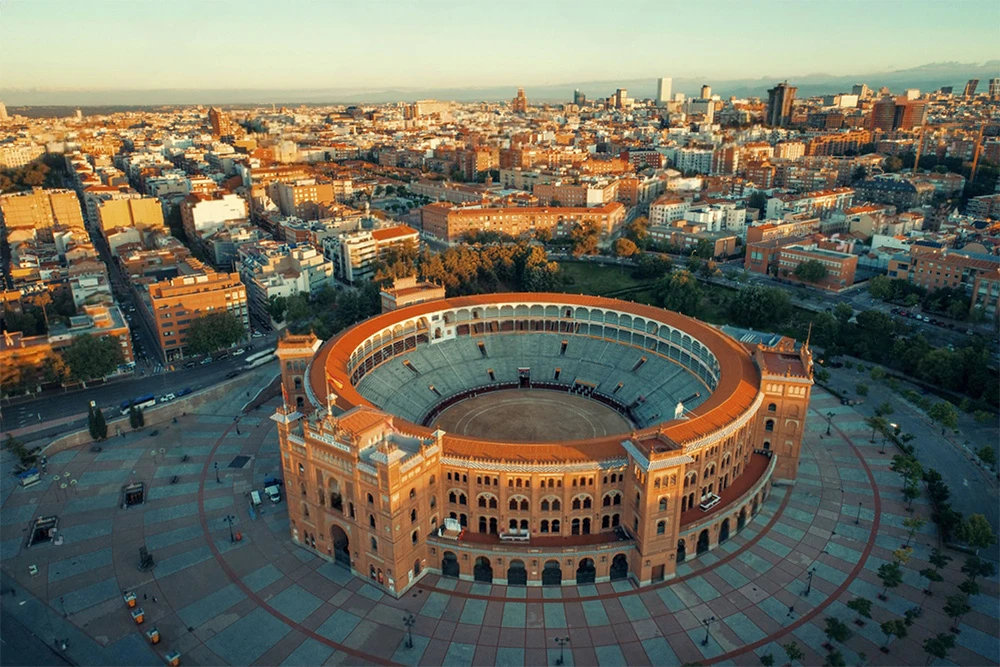
Where classics keep their voices, in velvet and shade
I still remember the hush that greets you, that cool breath of old wood and espresso drifting through the foyer. Cine Doré, a restored 1920s movie palace, feels like a pocket of time. Classic films unspool in their original languages no dubbing, just the grain, the crackle, and the voices as they were meant to be heard.
Outside, Madrid shimmers with heat; inside, the art nouveau curves and soft gilt details make the room glow like late afternoon. The café hums with locals who’ve slipped in to cool off, comparing favorite scenes over iced drinks while the next reel waits. It’s a gentle refuge, the kind that lets your shoulders drop without you noticing.
What stays with me is how the right voice changes everything the humor lands differently, the silences breathe longer, and you catch textures that subtitles can’t carry. It feels surprisingly tender, like the films are trusting you with their true selves, and you step back into the street a little lighter, as if you traveled far without going anywhere at all.
A time capsule metro platform under the city’s rush
I love when a place lets you hear its old heartbeat. Beneath the traffic, Andén 0 waits exactly as it did in 1966-cream tiles glowing softly, enamel signs catching the light, the platform edge scuffed by countless soles. There’s a faint scent of oil and damp stone, and the hush has a kind of kindness to it, like the station is taking a slow breath after decades of hurry.
They open it for guided visits now, and I remember how a whisper carried under those tiled arches, as if the walls were still listening for the next train. You can almost feel a morning crowd passing by in invisible waves someone late for work, someone clutching a bouquet, someone rehearsing a promise all of them folded into the air. The old clocks don’t scold; they just watch, patient.
What surprised me most was how hopeful it felt. A city always leaping ahead decided to protect a quiet room for its past, a bookmark tucked into a well loved novel so you can find your place again. It’s such a Madrid thing letting yesterday ride alongside tomorrow, not as a museum piece, but as a memory that still hums.

Where abundant water named the city
I love when a name hides a promise. Mayrit Arabic for “place of abundant water” still makes me hear fountains before I see them. Even on dusty afternoons in Madrid, the air feels a touch cooler, like the city keeps a bowl of water by the door for anyone who comes by.
Look long enough and the modern lines break to reveal a length of sober wall behind a café, a stub of watchtower tucked into a courtyard. They are witnesses to nearly two centuries when this was an Islamic outpost, stones quiet but steady, holding the heat of the sun by day and the night’s chill after. There’s a hush around them that you don’t get from glass.
I remember pausing by one of those stones and letting the noise soften. The city is a palimpsest, old ink showing through fresh pages. Even now, that old name seems to surface in small ways cool courtyards, shaded fountains, the quiet patience of brick reminding me how much abundance can outlast a century.
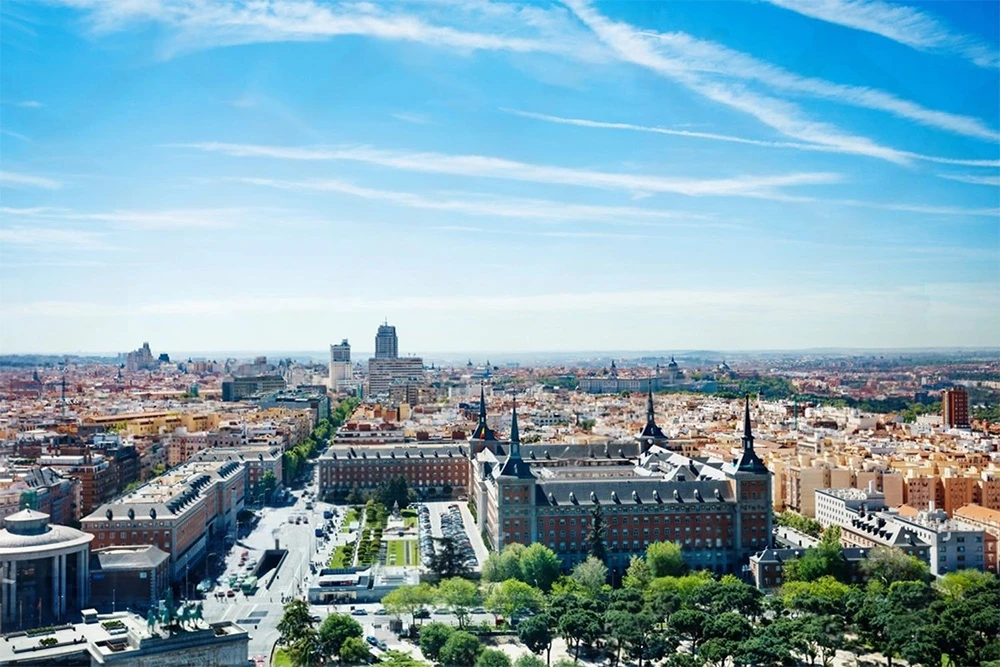
A grand palace with no king at home
It still makes me smile this idea that the largest royal palace in Western Europe waits, fully dressed, with no monarch sleeping inside. The rooms glow like a sunset caught in crystal, chandeliers trembling with memory, velvet soft under the eye, and somewhere you can almost hear the silverware rehearsing its clink. It feels so wonderfully Spanish: the grandeur is real, but it’s saved for moments that matter, a stage for pageantry rather than a private living room.
Once, during the free hours, I wandered into the Palacio Real in Madrid and felt the cool marble hush rise around me, like walking into a held breath. For a little while, the gilded mirrors and solemn portraits treated me like I belonged there, and I swear I borrowed a crown for an hour no jewels, just the quiet lift of being welcomed by beauty that isn’t fenced off. That’s the charm of it: a palace that doesn’t guard a king, but opens its doors so the city can share the splendor, one careful step at a time.
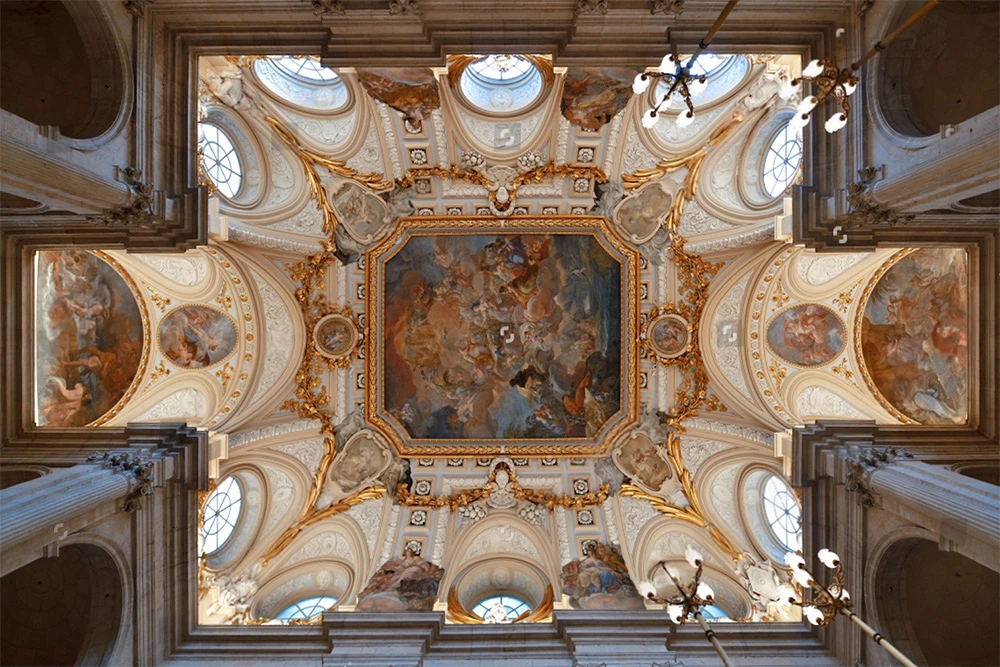
Nights that Linger Until Churros and Sunrise
There’s a moment when you realize the music isn’t stopping. In Madrid, the clock seems to yawn and roll over, and the crowd keeps laughing. The clubs don’t blink at six or even seven; they just stay open, steady and bright, and you feel unexpectedly awake, the bass warm in your chest and a good hum under your skin.
Doors open and people drift out into cafés where espresso hisses and oil crackles for churros. Dawn lays a pale pink on the cobblestones, and the air smells like sugar and coffee and a little bit of last night’s perfume. I remember that first sip of thick chocolate, how it quieted the buzz just enough to make room for a soft, fizzy happiness.
It isn’t just the late hours; it’s the way the night refuses to end, as if you could stretch a single evening into a tiny lifetime and still have room for breakfast before bed. That pulse makes every outing feel like a story waiting to happen, and you head home with tired feet and a full heart, surprised by how easy it is to believe in more.
A palace made of light and leaves
I remember the air turning soft the moment I stepped inside cool, a little sweet, the kind of damp that loosens your shoulders. Sunlight breaks across the glass into gentle patches, and the palms lace the floor with green shadows. This 19th century glasshouse, once built to show off tropical wonders to the world, still glitters like a lantern tucked into the green.
Sometimes you find contemporary art set among the fronds: delicate threads, quiet sounds, a sliver of metal catching the afternoon. The light does half the work, pouring through the ribs of the building until the whole place feels like a snow globe of summer you can walk into. I remember standing still just to hear the soft echo of the room breathing.
What gets me is how something made for distant plants now shelters new ideas, as if the past and present agreed to share the same sun. In Madrid’s Retiro Park, the Crystal Palace isn’t just lovely it’s a reminder that curiosity ages well, and that wonder can be both sturdy and weightless at once.
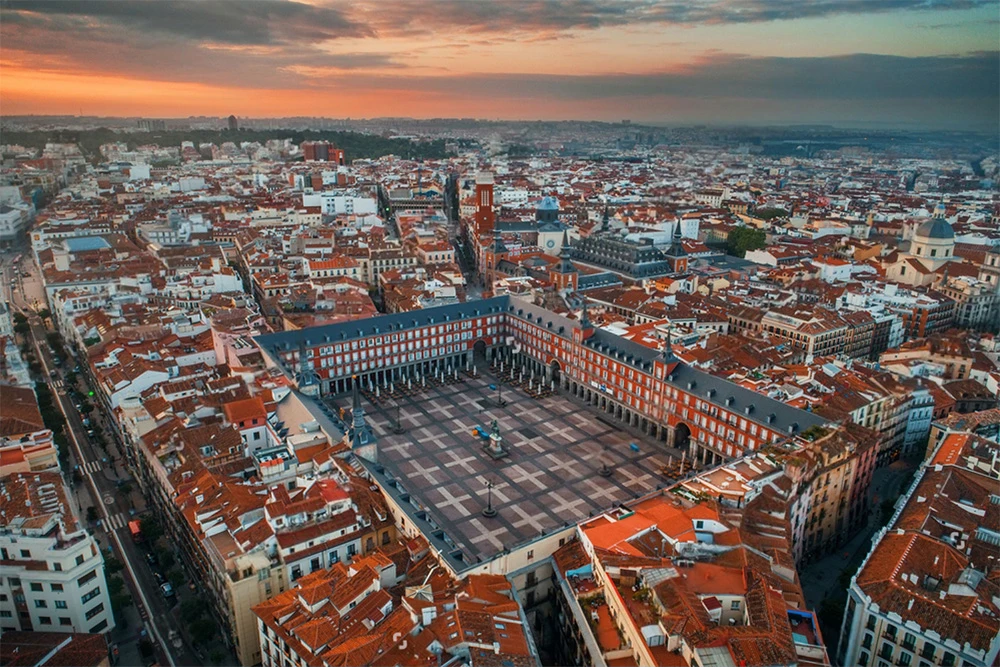
Weeknight sunsets set the temple softly aglow
There’s a hush just before the lights come on, and then the old stones bloom with honey gold. Around the lawns, blankets unfurl, couples lean into the breeze, and a quiet row of photographers waits like patient herons for the sky to blush. The reflecting pools take on the deepening colors, the air smells faintly of warm grass, and conversation slips to whispers.
Once, on a Wednesday, I found an empty bench with room to breathe; the only soundtrack was laughter drifting from picnics and the soft click of shutters. Sitting there at Templo de Debod, it’s hard not to feel that even ordinary days can turn special when the sunset arrives without a rush. Weeknights are kinder here quieter, unhurried and the colors linger long after the lights fade.
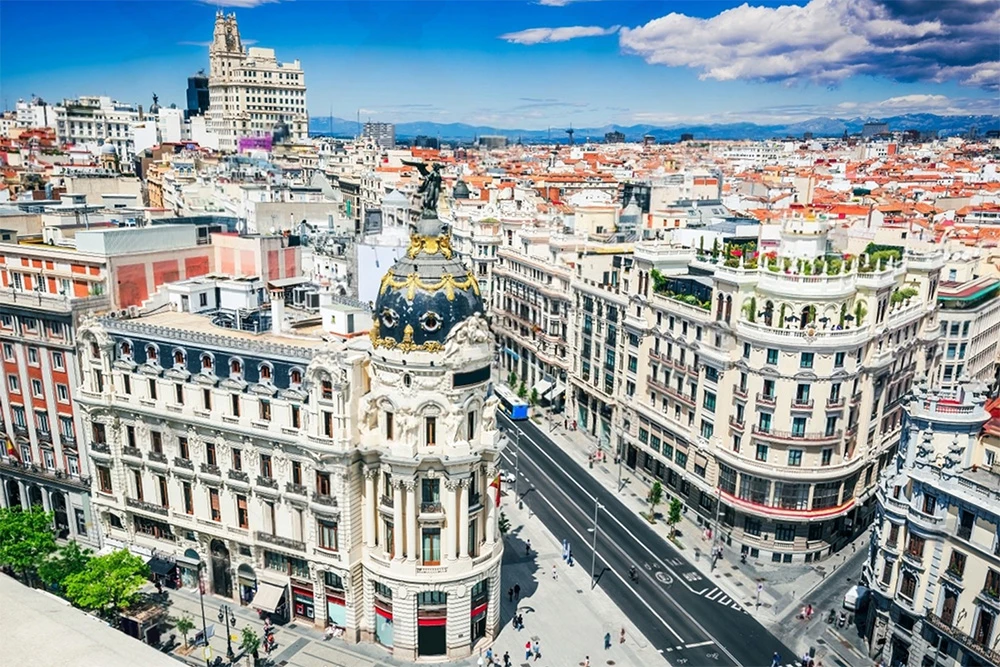
Plaza Mayor’s stage from coronations to quiet dawns
At first light, the square grows hushed, as if the air is waiting its cue. Stone turns soft and pale, balconies catch a sleepy orange glow, and the faint clink of cups drifts out from the arcades. In that hush, it feels like a stage before the curtain rises, and for a moment you half expect cloaks and trumpets to step out of the shadows.
Then I remember what this place has held: royal coronations, bustling markets, even the stern gaze of public trials. Madrid’s Plaza Mayor carries all of it without fuss, history stitched into the cobblestones so neatly you only notice when the morning quiet lets you. It’s a strange tenderness, feeling the cheer and the grief layered under your feet, and realizing how time can live politely with the present.
By late morning the arcades are warm with chatter, cozy cafés breathing out the smell of coffee while art vendors brighten the edges with color. I love how the square doesn’t choose between ceremony and everyday life it just welcomes both, like an old friend who sets another chair at the table. I remember thinking, this is the city’s heartbeat: steady, generous, and always ready for the next scene.

A quiet garden where Sorolla’s light still lingers.
The hush came first the sudden softening of traffic into leaf sound. The Sorolla Museum is tucked just off a broad Madrid boulevard, but its garden carries its own weather: water whispering through narrow channels, Moorish tiles cool under the palms, a citrus clean breeze that loosens the shoulders. It’s the kind of calm that makes time stop fidgeting.
Inside his former home, light gathers on the walls as if it never left him women in white, waves that seem to move even when you’re still, skin warmed by late afternoon. Those canvases feel humble and generous at once, like bottled sunlight saved for days when the sky won’t cooperate. I left with the quiet sort of joy you don’t want to speak too loudly, the reminder that beauty can live right off a noisy street and still change the rest of your day.
Beyond the Golden Triangle, quiet rooms of wonder
Funny how the famous museums blaze like marquee lights in your mind the Prado, Reina Sofía, and Thyssen Bornemisza and it’s easy to feel full, almost dazzled. But the surprise sneaks in close by, where the noise fades and the floorboards start to whisper.
The petite places are the ones I kept thinking about later: the Museum of Romanticism with velvet walls, polished wood that smells faintly sweet, and portraits that seem to lean closer in the soft lamplight; the Museum of the Americas with its quiet gold, featherwork, and cool air that settles on your skin like shade at noon. Walking into them feels like slipping through a side door of time. Sometimes you get an entire room to yourself, the hush so complete you notice the gentle tick of your own breath.
I remember standing there and feeling oddly chosen, as if the art had decided to meet me halfway. That’s the beautiful trick of Madrid: grand spectacle in one breath, and in the next, an intimate corner where your thoughts can stretch out and linger. It’s an art lover’s paradise, yes but also a place that hands you solitude, the kind that makes color, silence, and history feel personal.
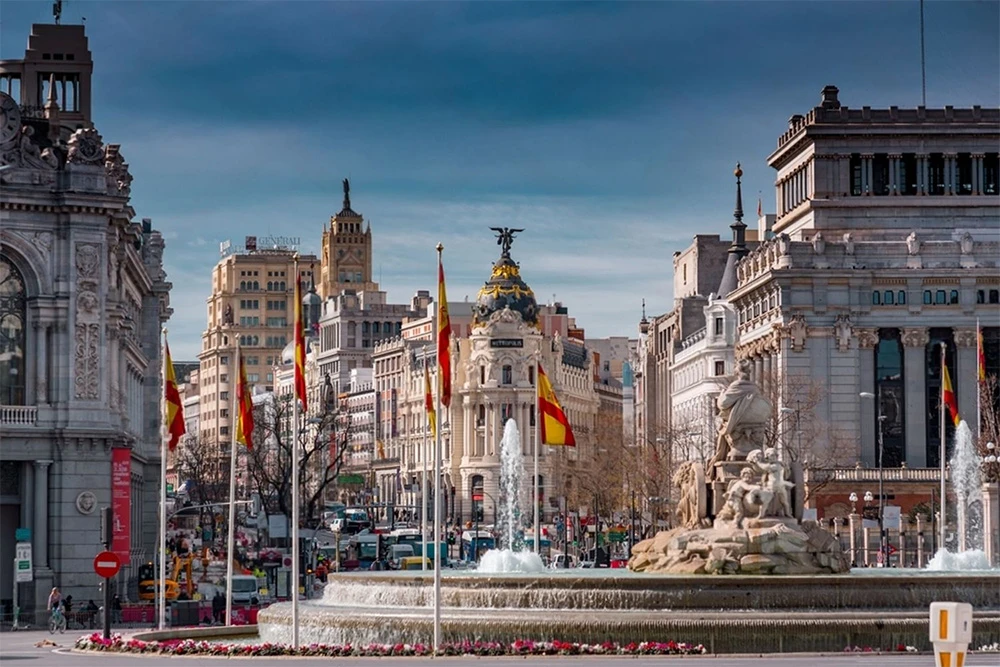
High altitude capital where winter nips and skies blaze
Some mornings the cold touches your face before you’re fully awake, and the sky looks impossibly, almost defiantly blue. Your breath hangs for a moment, coffee warms your hands, and the streets throw crisp, tidy shadows. I remember how everything felt extra clear on days like that, and somehow even small routines carried a little brightness.
It sits more than 660 meters above sea level, one of Europe’s highest capitals, and you can feel it in the weather winter has teeth, but the light is generous. In Madrid, that mix makes conversation warmer, plazas livelier, and even a quiet walk feel buoyant, like standing on the rooftop of a continent with the day spread wide around you.
A vault ready to drown its secrets
I still smile at the thought of a place that would flood itself before giving in. It sounds like a screenwriter’s twist, but the idea hangs in the warm air outside that stately bank something stern and oddly romantic resting below all that marble.
They say an old vault beneath the Bank of Spain is rigged to unleash the city’s own underground river if anyone ever tries a heist, a quiet deluge waiting under Madrid. I remember the cool shade along the facade, the distant vibration of traffic, and imagining the muffled rush of unseen water calm, certain, almost indifferent to panic.
What I love is the attitude of it: not fear, but stubborn cleverness, a place trusting its own depths to guard what matters. It’s dramatic, a little cheeky, straight out of a heist film, and somehow it feels right here engineering with a streak of poetry.

A secret garden of mazes and peacocks
It’s funny how your voice softens on its own the moment you step somewhere truly gentle. Out beyond the usual streets, an 18th century garden spreads out quietly hedges clipped into wandering mazes, pavilions dappled with sun, and peacocks stepping across the grass with that casual, regal confidence. The air smells of damp leaves and something sweet, and you notice how few people talk about this place, the kind locals gently keep to themselves.
Parque de El Capricho has that softness that makes time feel wider. I remember standing under a canopy of green and feeling the day loosen its grip, the maze training my thoughts to slow while the pavilions seemed to hold their own little pockets of calm. It felt like a secret passed from palm to palm, a daydream stitched with hedges and blue feathers.
Maybe that’s the magic of being a little outside the center you get to be the guest, not the crowd. You leave with your shoulders lower and your senses awake, carrying a hush you didn’t know you needed, and the quiet promise that some wonders don’t need to be announced to be real.
Twelve grapes, twelve chimes, a year’s small promise
The first chime always catches me off guard, like a bell nudging the quiet open. Then the grapes begin one for each ring, luck tucked into every burst of sweetness. In Madrid, I remember the clock sounding round and bright while the city held its breath, and we tried to keep pace, skins slipping, laughter fizzing up with the cava. It feels a little like threading beads onto a string of seconds, each one a soft hope for what’s about to begin.
There’s a trick to getting all twelve down in time, locals say with a grin, and it’s never the same advice twice. Honestly, half the fun is in the mishaps: cheeks puffed like chipmunks, a rogue seed that sends someone giggling through chime eight, the way friends trade “grape fail” stories like charms against bad luck. I love that how the city steps into the new year with sticky fingers and shining eyes, turning superstition into shared joy, and letting the luck skip forward like stones into January.

Carnival skirts and accordion swept plazas
It hits you first in the ears the warm wheeze of an accordion, like a friendly sigh and then the plaza tilts into joy. I remember the way polka dots flashed and heels tapped, and suddenly the square felt like a carousel that forgot to stop. The air smelled faintly of churros and cologne, and strangers clapped in time until they weren’t strangers anymore.
Chulapos and chulapas appeared as if the city had opened a family album: flat caps, sharp waistcoats, bright carnations, shawls draped with quiet pride. They danced the chotis, turning gently around each other while the music stitched old Madrid to the afternoon. What got me wasn’t the nostalgia so much as the kindness of it how tradition isn’t a museum; it’s a neighbor who insists you share the floor, and for a few songs the whole plaza becomes your living room.

Amber evening skies that painters still chase
Some evenings, the city exhales honeyed light, and the rooftops look rinsed in watercolor. The air feels warm and a little dusty, and even the laundry on the lines takes on a quiet glow.
They call it “cielos de Madrid” an amber sky that once filled the eyes of Goya and Velázquez and still makes even the most casual feeds look tender. I never expect it, and then suddenly everything is softer: stone, faces, the chatter from open windows.
I remember pausing mid sentence with a friend because the street seemed newly gentle, the tiles holding the day’s warmth and the shadows long and unhurried. It’s such a simple thing, a sky the color of apricots, yet it gives this place a steady kind of confidence, the feeling that you’re exactly where you’re meant to be.

Four centuries of Sunday secrets at El Rastro
Sundays there feel like the city humming an old song. El Rastro unfurls down the hill with the clink of old keys, the papery scent of postcards, the mellow sheen of vinyl and leather. It has returned, almost without fail, every Sunday for nearly four hundred years, and the morning seems to hold that long memory with easy, familiar grace.
I remember a gray bearded luthier letting a single note ring from a handmade guitar – bright, woody, a little imperfect – and strangers smiled as if they recognized an old friend. Nearby, a woman in a velvet jacket told small histories with every price: a coat worn to a first dance, a tin toy that “never broke a heart.” In Madrid, the market isn’t just things; it’s the way people trade fragments of themselves until the day feels like a shared attic, where vintage treasures wait patiently for the right hands.
Vintage bubblers pour summer cool sips for wanderers
There’s a particular hush when cold meets a hot day, as if the street exhaled. The old fountains keep a soft burble, bronze dark with age, spring cold water running clear and fast. You catch the clean smell of wet metal and stone, and the taste is crisp, like biting into an apple.
People here talk about them with the kind of fondness saved for small rituals, the quiet habits that make a neighborhood feel like itself. In Portland, some neighborhoods keep these vintage bubblers because they’re part of daily life steady, generous, always there when the heat builds. I love how something so simple can feel like care: a cool mouthful, a brief pause, and the afternoon feels lighter just enough to keep going.
When the side streets quietly steal the whole show
It always surprises me how the side streets feel like a second heartbeat. Step off the grand avenues and the light softens; shutters blink, someone laughs from a balcony, and color blooms on worn walls. In Malasaña the murals seem freshly dared, layers of paint and pride, while in La Latina someone has slipped a poem between posters, prosecco fizz catching the last of the evening glow. The air tastes like garlic and good trouble.
This is the Madrid that feels fresh and a little mischievous, the kind that lets you belong without asking. Tapas bars hum in a warm, continuous swirl padrón peppers popping, anchovies gleaming on white plates, napkins rustling under elbows; chatter rises and falls like a tide you can float on. I remember lingering until my fingers smelled of lemon and olive oil, that quiet click of knowing the best thing wasn’t a landmark but the feeling that this corner edges and all was suddenly, sweetly yours.
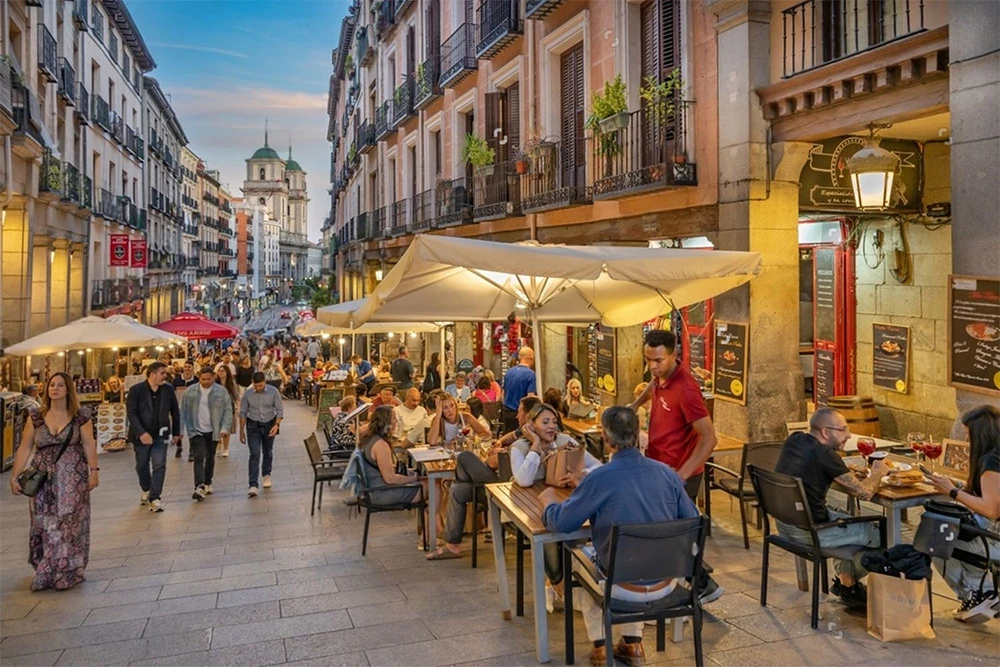
Final thought
All these hidden stories, the small details, the human moments glances at crosswalks, a scuff on a stair, a laugh that lingers add up to something that feels true about Madrid. Taken together, they settle into place like a mosaic pieced from humble tiles. In the pause of a doorway, in the shared nod on a bench, in the care of closing hands, a quieter city comes through. I walk on with open eyes, ready to keep noticing.


